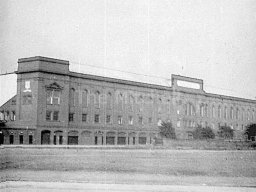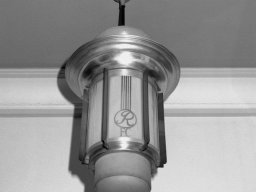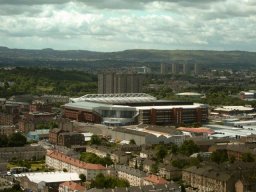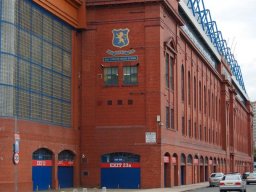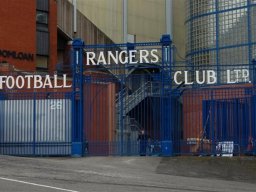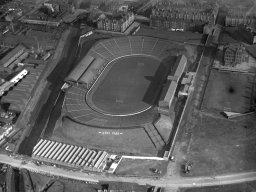Ibrox Stadium, originally Ibrox Park, is the stadium of Rangers F.C. It is located on the south side of the River Clyde in the Ibrox district of Glasgow. As one of the oldest and largest stadia in Britain, as the site of two major disasters and as one of the first wave of predominantly all-seater football grounds, Ibrox is a stadium of widely acknowledged architectural and historic significance.
The site of Ibrox Park has been the home of Rangers since 1899. On April 2, 1902 during the annual international game with England, twenty five people were killed and over 300 injured when a wooden stand collapsed in what was then football's worst disaster.
Online Museum
Read more about the Ibrox Disasters here.
In 1929 the construction of the Main Stand, to the south side of the ground, began. Its designer was Archibald Leitch, the Scottish engineer responsible for stands at the grounds of Arsenal, Manchester United, Everton, Tottenham Hotspur, Chelsea and Aston Villa. Leitch's work was later to become amongst the most celebrated of football architecture. The Main Stand at Ibrox provides a classic example of Leitch's characteristic style of criss-cross steelwork balustrades. Like Leitch's stand and pavilion at Fulham's Craven Cottage, the architectural significance of the Ibrox Main Stand is reflected in its status as a listed building.
Online Museum
Read more about Archibald Leitch - the Designer of Ibrox - here.
With the Main Stand completed, the bowl-shaped ground was one of Britain's largest football stadia, second only to Hampden Park, also in Glasgow's south side. A record crowd of 118,567 gathered in January 1939 for a league match with Celtic. This remains the record attendance for a
The appearance of the stadium changed little for several decades, until a dramatic redevelopment over the final decades of the twentieth century. The first major innovation came with the construction of the Copland, Broomloan and Govan stands in the late 1970s and early 1980s. This involved a radical reshaping of the stadium, with the old bowl-shaped configuration replaced by three new, free-standing stands, alongside the remaining Main Stand.
It was another Old Firm game, the fateful one on January 2 1971 when 66 people died in the second Ibrox disaster, that was the catalyst for Rangers' ground to become all-seater.
Online Museum
Read more about the Ibrox Disasters here.
Manager Willie Waddell had the vision. He believed that steep terracing and exits, such as the one where the disaster happened on Staircase 13, had to go. He visited the Dortmund ground in Germany and began to lay the foundations for the changes which culminated in today's Ibrox Stadium.
In 1973, 10,000 bench seats were fitted on the north terracing as a temporary measure, becoming known as the Centenary Stand. By 1978 the east terracing was being ripped up and a year later the Copland Road Stand was in its place.
By 1981 the Centenary Stand had been demolished and replaced with the Govan Stand with 10,300 seats. The sum of £10 million was spent in the first decade after the disaster. The stadium was changing from its familiar oval shape into the current rectangular structure.
The result of this ambitious redevelopment was what was widely acknowledged as by far the most modern club football ground in Britain. A capacity of around 44,000 was considerably smaller than the 85,000 or so that had preceded it. However, the redeveloped Ibrox, with some 36,000 seats, foreshadowed the advent of all-seated stadia for all Britain's principal football clubs, as required by the Taylor Report of 1989.
A further series of developments was instituted in the early 1990s to enable the stadium to comply with the requirements of the Taylor Report. A third tier - the Club Deck - was added to Leitch's Main Stand. The remaining standing areas of the ground, the east and west enclosures of the Main Stand, were seated at around the same time. In an effort to expand the stadium's capacity, the configuration of the now all-seated stadium was altered in the mid-1990s, and two additional areas of seating added in the spaces between the Govan and Copland/Broomloan stands. The ground's name was officially changed to Ibrox Stadium after renovations completed in 1997. By 2005, the stadium's all-seated capacity was 50,411.
In 2006, a further series of incremental increases in the stadium's capacity began with the addition of two rows of seating on the front of the upper tier of the Govan stand. Linked to a new 'Bar 72' area (named in honour of the club's triumph in the 1972 European Cup Winners' Cup), the new area accommodated 671 'premium' seats. At the club's AGM in 2006, chief executive Martin Bain announced that further schemes were probable for the Copland and Broomload stands, raising overall stadium capacity by around 800 to a total of approximately 51,900.
In partnership with the Las Vegas Sands corporation, the club sought to develop land adjoining Ibrox as the home of Britain's first 'regional casino' (also called 'super casino'). The casino was to be accompanied by a Rangers-themed leisure complex. Glasgow City Council approved outline planning permission for the development at Ibrox (as well as others elsewhere in the city). Britain's Casino Advisory Panel reviewed bids from eight short-listed cities and in 2007 awarded the first license to Manchester. There is no immediate prospect of the Ibrox proposal being resurrected.
The Main Stand was renamed the Bill Struth Main Stand in September 2006 to commemorate the 50th anniversary of the death of the club's most celebrated manager. In 2014, the Govan Stand was renamed after Sandy Jardine after the Rangers legend's death earlier that year.
The stadium is one of 28 European stadiums which have UEFA's 5-star rating, enabling it to host finals of the UEFA Champions League and the European Championship.
Tours of the stadium are available - see the official Rangers website for details.
Discuss this article
Enjoyed this article? Disagree entirely? Found a spelling mistake? Whatever your opinion, it's welcome on our popular and friendly message-board.




